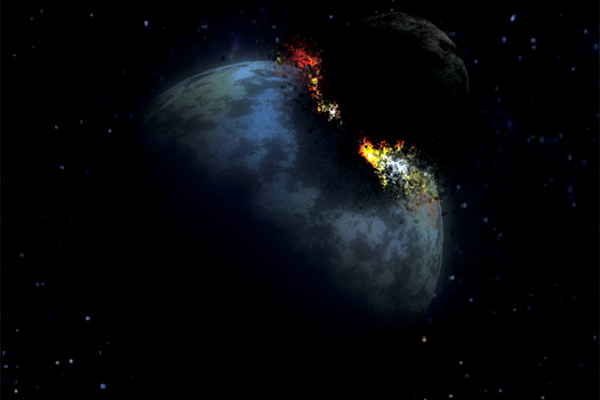Armageddon: Asteroid Splitting Doesn't Work

In the nail-biting climax of the blockbuster film, Armageddon, Harry (Bruce Willis) sacrifices himself to save the planet by lowering himself into a deep fissure and detonating a nuclear bomb, splitting the asteroid in half. Audiences cheered. But scientists groaned.
Armageddon is a perennial favorite target for so-called "nerd-gassing" among the geekerati. Its Wikipedia entry cites at least 168 scientific errors, over a running time of 150 minutes. That's more than one howler per minute. This is why Bad Astronomer Phil Plait often lists it as his choice for the worst science in film, detailing the most egregious errors in a classic 2001 blog post.
SLIDE SHOW: Top 10 Ways to Stop an Asteroid
Here's a sampling. The opening narration grossly underestimates the energy of that dinosaur-killing asteroid that hit Earth 65 million years ago. Objects in space tend to be shaped like spheres because of gravity, yet the asteroid is shown to be jagged with jutting spikes -- plus there's a mysterious vapor. A gravity scene aboard a Russian space station gets the direction of gravity wrong. Oh, and at one point, a military leader refers to NASA as "Nassau."
About the only scientific fact the movie got right is that asteroids do actually exist.
And the nerd-gassing continues. A new analysis by a group of graduate students at the University of Leicester reveals that all other howlers aside, the nuclear bomb Harry detonates wasn't nearly large or powerful enough to split an asteroid of that size.
HOWSTUFFWORKS: Could we stop an asteroid on a collision course toward Earth?
Get the world’s most fascinating discoveries delivered straight to your inbox.
Their conclusions appeared in a pair of papers published in the university's Journal of Special Physics Topics. It features short papers written by fourth-year master's students, to give them a flavor of what publishing in a 'real world' academic journal is like.
Creativity is encouraged. So Ben Hall, Gregory Brown, Ashley Back, and Stuart Turner took a closer look at Harry's foolproof plan for saving the Earth from a killer asteroid impact -- and found it wanting.
First, nobody seems to notice the asteroid on a collision course with Earth until 18 days before impact. Scientists would need to detect the asteroid much earlier in order to have time to implement such an elaborate scheme, which is why NASA monitors all such bodies closely.
Second, that nuclear bomb wasn't nearly powerful enough to split an asteroid of that size. The students devised a formula by figuring out just how much kinetic energy would be needed to do so, given the volume and density of the asteroid, its velocity, and its distance from Earth at the point of detonation, based on details gleaned from the film.
Their conclusion: it would take 800 trillion terajoules of energy to split that asteroid in half in such a way that both halves cleared the planet. The USSR's 50-megaton bomb, "Big Ivan," was the most powerful nuclear weapon ever detonated on Earth, amounting to 418,000 terajoules. Impressive though that is, we would need something a billion times stronger for Harry's plan to work.
ANALYSIS: Wake Up and Smell the Science, Hollywood!
Plait made a similar point in his original 2001 review:
Imagine the asteroid four hours before impact. Each half must move away fast enough to cover 6400 kilometers (the Earth's radius) to miss the Earth. Anything less than this means an impact. In turn, this means each half must be accelerated to a speed of 6400 km/ 4 hours=1600 kilometers an hour. That's about 1000 miles per hour, or about twice as fast as a passenger jet. But wait! This asteroid is 1000 kilometers across! It is extremely massive, and something with that much mass would take an enormous amount of energy to get moving that fast; about a hundred billion megatons, or very roughly the same amount of energy the Sun produces every second. Needless to say, one bomb ain't gonna do it. A billion or so might though. I don't think even Bruce Willis is up to that task.
For the students, it was quite the eye-opener into Hollywood science. "I really enjoyed Armageddon and up until recently never really considered the plausibility in the science behind the movie," said Hall. "But after watching it back, I found myself being more skeptical about the film."
Of course, a blockbuster film is not a science documentary, nor should it be: fiction is all about the make-believe. But good science can make for a more plausible narrative, making it easier to suspend disbelief.
Science fans like Hall et al. are just doing their part to hold Hollywood accountable for its gaffes -- and have a bit of fun in the process.
This story was provided by Discovery News.


